|
|
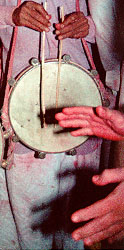
Drums and Dust
Pune's Ganapati Festival, 1986
a travel recollection by Warren Senders
 Sounds are Real Audio format.
Sounds are Real Audio format.
It was September 1986, and I had been in India a year, living in the city of Pune, one-hundred-thirty miles from Bombay in the state of Maharashtra. Every year at this time came the festival honoring the birth of Ganesh, one of the most beloved Gods of the Hindu tradition. Called Ganapati, this ten-day period had been celebrated for centuries, but it was not until the beginning of the modern Indian independence struggle that the festival came into its own. At the instigation of radical reformer B. G. Tilak, the Ganapati festival become a focus of Indian nationalist energy and a means to touch the common people's hopes and aspirations. Now, four decades after Indian independence, the festival was pure and simple celebration -- especially in Maharashtra, and especially in Pune.
Ganesh is a curious God. With a human body and an elephant's head, he seems a little comical, and sometimes grotesque - but benevolent. Pot-bellied and enormous, he rides everywhere...on a mouse. Generous and friendly, he sometimes holds deadly weapons; though part animal, he is recognized as one of the great scholars of the Hindu pantheon. New projects are inaugurated with offerings to Ganesh, and in every Hindu household a little Ganesh murti (statue) overlooks the room. In Maharashtra, Ganesh is a very highly regarded diety, and when it comes time to rejoice in his birthday, people from all social and economic levels join in the revelry.
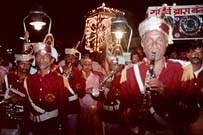 For weeks community groups had been practicing drumming and dancing -- their
contributions to the final day's parade, where idols of Ganesh would be
slowly taken from Pune center down to the edge of the river and allowed to
dissolve in the sluggish stream. All Pune's brass bands polished their
repertoire and their instruments. Big gunny sacks of lurid red powder
appeared in shops, and every street corner sprouted temporary stages with
walls of corrugated metal. By the time the ten days of the offical festival
began, the city was at a fever pitch of excitement, and as the last day
approached, the drumming got more and more exuberant, the brass bands blared
happily, and the street-corner stages displayed scenes from Hindu mythology
accompanied by raucous recordings of devotional singing played back over
loudspeakers overloaded beyond imagining.
For weeks community groups had been practicing drumming and dancing -- their
contributions to the final day's parade, where idols of Ganesh would be
slowly taken from Pune center down to the edge of the river and allowed to
dissolve in the sluggish stream. All Pune's brass bands polished their
repertoire and their instruments. Big gunny sacks of lurid red powder
appeared in shops, and every street corner sprouted temporary stages with
walls of corrugated metal. By the time the ten days of the offical festival
began, the city was at a fever pitch of excitement, and as the last day
approached, the drumming got more and more exuberant, the brass bands blared
happily, and the street-corner stages displayed scenes from Hindu mythology
accompanied by raucous recordings of devotional singing played back over
loudspeakers overloaded beyond imagining.
On the festival's last day, people assembled in the city center, a tightly congested maze of tiny streets running at odd angles around a central vegetable market. At about ten in the morning, the first of the Ganesh idols began the three-mile trek to the river bank -- sitting on a cart, decorated with garlands of flowers. The city's main commercial street, Laxmi Road (named, naturally, after the Goddess of Wealth) was closed to all traffic, and the crowds grew and grew. Even during the blistering afternoon heat thousands of people lined the street, watching Ganesh after Ganesh, drum troupe after drum troupe, brass band after brass band. The parade's pace was very slow; it would be 24 hours before the final Ganesh reached the river. I arrived at midday, armed only with a camera, and stood at the curb for hours.
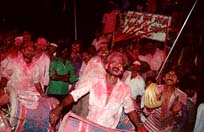 As evening arrived I struggled against the crowd to get back to my flat; I
was planning to brave the last night of Ganapati, where the crowd was at its
thickest and the music the hottest. I prepared for the trip out as if I was
an astronaut:
first, the tape-recorder strapped to my skin, then a t-shirt with the
microphone cord carefully threaded through the armhole. Then a floppy,
long-sleeved Indian kurta, with the cable going through the sleeve and
connected to a small microphone wrapped in plastic and covered with two socks
and mounted on the end of a 2-foot stick; the headphones went in my ears. My
camera too was covered with plastic; flash batteries charged, fresh film
loaded. Finally, I brought out the dental floss and tied my spectacles
tightly, and put my funkiest skullcap over the whole assemblage. I was ready
for anything.
As evening arrived I struggled against the crowd to get back to my flat; I
was planning to brave the last night of Ganapati, where the crowd was at its
thickest and the music the hottest. I prepared for the trip out as if I was
an astronaut:
first, the tape-recorder strapped to my skin, then a t-shirt with the
microphone cord carefully threaded through the armhole. Then a floppy,
long-sleeved Indian kurta, with the cable going through the sleeve and
connected to a small microphone wrapped in plastic and covered with two socks
and mounted on the end of a 2-foot stick; the headphones went in my ears. My
camera too was covered with plastic; flash batteries charged, fresh film
loaded. Finally, I brought out the dental floss and tied my spectacles
tightly, and put my funkiest skullcap over the whole assemblage. I was ready
for anything.
 A mile from my apartment the entire world had changed irrevocably. The air
was chokingly thick with dust; drums clattered all around, and occasionally a
whole truckload of revelers would move by at about 1 mile an hour. As a
foreigner, I was highly visible, and a natural target for handfuls of powder; by the time I'd reached the main part of the city I was a bright red
everywhere, and deeply grateful I'd had the foresight to keep my camera in
plastic. I reached under my shirt and turned the tape recorder on.
A mile from my apartment the entire world had changed irrevocably. The air
was chokingly thick with dust; drums clattered all around, and occasionally a
whole truckload of revelers would move by at about 1 mile an hour. As a
foreigner, I was highly visible, and a natural target for handfuls of powder; by the time I'd reached the main part of the city I was a bright red
everywhere, and deeply grateful I'd had the foresight to keep my camera in
plastic. I reached under my shirt and turned the tape recorder on.
 For the next four hours I moved through Pune's congested city section,
stopping wherever the drumming was hottest. These groups featured the
shallow kettle-drums called "tasha," as well as a huge bass drum played
horizontally with a stick like a small baseball bat, and a lot of small hand
cymbals about five inches in diameter, clashed together in a simple unison
beat. But it was the tasha that dominated. Tuned fantastically high,
they're played with thin, whiplike sticks. Their sound is piercingly sharp
and penetrating, and the good players rattled off steady streams of
brilliantly accented sextuplets above the deep pulse of the bass drum and the
cymbals' steady clang. It was exhilarating.
For the next four hours I moved through Pune's congested city section,
stopping wherever the drumming was hottest. These groups featured the
shallow kettle-drums called "tasha," as well as a huge bass drum played
horizontally with a stick like a small baseball bat, and a lot of small hand
cymbals about five inches in diameter, clashed together in a simple unison
beat. But it was the tasha that dominated. Tuned fantastically high,
they're played with thin, whiplike sticks. Their sound is piercingly sharp
and penetrating, and the good players rattled off steady streams of
brilliantly accented sextuplets above the deep pulse of the bass drum and the
cymbals' steady clang. It was exhilarating.
 Indian brass bands have had little exposure in the West; most play primarily
for weddings and festivities, and their members have other jobs as primary
income sources. With an electric organ mounted on a wheeled cart with a
generator, these groups go to new extremes of volume. One, the "Sangam Brass
Band," gave a rendition of a popular Hindi film song, suddenly dropping the
volume midway through the piece to let the trumpeter take a long solo
accompanied only by organ drones and percussion. He played lyrically in a
good approximation of the Indian classical style; only when the other horns
returned with the refrain did the serenity dissipate.
Indian brass bands have had little exposure in the West; most play primarily
for weddings and festivities, and their members have other jobs as primary
income sources. With an electric organ mounted on a wheeled cart with a
generator, these groups go to new extremes of volume. One, the "Sangam Brass
Band," gave a rendition of a popular Hindi film song, suddenly dropping the
volume midway through the piece to let the trumpeter take a long solo
accompanied only by organ drones and percussion. He played lyrically in a
good approximation of the Indian classical style; only when the other horns
returned with the refrain did the serenity dissipate.
Sometimes at a single street corner the drums and brass from all directions mixed in a bizarre and uplifting clash of sound; if Charles Ives had grown up in India, what music he would have composed! I held my microphone high above the fray, listening through the headphones to the kaleidophonic soundscape.
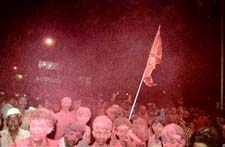 The long night wore on. Every ten or twenty minutes I'd briefly lift the
plastic cover on my camera and shoot a couple of frames (always checking to
be certain no powder-flingers were in the neighborhood!) before moving on to
another corner, another band, another tight little clump of two or three
hundred people. Periodically I'd duck into a little tea-shop and let a
one-rupee cup of hot, milky, sugary tea replenish my flagging energies. By
four a.m. I was completely wiped out -- but the festival was still roaring
happily. I made it home (a distance of about two miles) by five-thirty; it
took over an hour of bathing to get the red out of my hair and off of my
skin. By the time the last of the Ganesh idols were brought down to the
river to dissolve, I was asleep -- to awaken with the mother of all sore
throats (which my doctor assured me was shared by half the city) -- brought
on by dust inhalation.
The long night wore on. Every ten or twenty minutes I'd briefly lift the
plastic cover on my camera and shoot a couple of frames (always checking to
be certain no powder-flingers were in the neighborhood!) before moving on to
another corner, another band, another tight little clump of two or three
hundred people. Periodically I'd duck into a little tea-shop and let a
one-rupee cup of hot, milky, sugary tea replenish my flagging energies. By
four a.m. I was completely wiped out -- but the festival was still roaring
happily. I made it home (a distance of about two miles) by five-thirty; it
took over an hour of bathing to get the red out of my hair and off of my
skin. By the time the last of the Ganesh idols were brought down to the
river to dissolve, I was asleep -- to awaken with the mother of all sore
throats (which my doctor assured me was shared by half the city) -- brought
on by dust inhalation.
It's been almost ten years since that incredible night, and nowadays Pune's Ganapati festival is somewhat more carefully produced. It's presented as a tourist attraction, with concerts, athletic events, special dramatic productions and other activities. But the long final night never changes. The drums still resound through the tiny city streets; the brasses still play their most impressive tunes -- and the red powder flies everywhere. When you go to the Pune festival, bring a breathing mask - and be ready to dance!
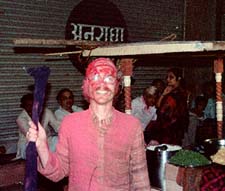
Warren Senders is a musician and composer who has worked extensively in India, learning traditional music and spreading the word of jazz. All photos and sound samples were taken by the author. All text, sounds and photos copyright 1995 Warren Senders
|
|